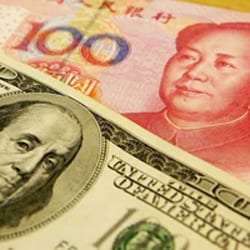Last Saturday, when I video chatted with my parents back in China, my mother talked about the devaluation of the yuan, or renminbi (RMB) again. This was the third time I heard her complaints in the past few months. It all started when People’s bank of China lowered the RMB’s daily fix against the dollar in August, leading to the biggest plunge in the currency’s value since the mid-1990s. This means my parents have to pay more for my tuition at Rice University. My mother also mentioned that my cousins who study in Japan and Singapore don’t face the same problem. She feels so strange and unlucky.
For my family, we do not want further depreciation of the RMB, at least in the short term. But the policymakers in Beijing won’t agree. In other major economies, such as Europe and Japan, quantitative easing and other policies have resulted in a depreciation of the euro and yen against the dollar. Meanwhile, the RMB remained stable against the strong dollar until August. This means that the RMB’s exchange rate weighted against its trading partners in Europe and Japan appreciated dramatically over the past years. In fact, from June 2014 to November 2015, the RMB’s real effective exchange rate was the world’s strongest, increasing by 15.5 percent, more than that of the U.S. dollar (14.8 percent). Therefore, although the RMB depreciated against U.S. dollar in recent months, it appreciated or remained nearly flat against other currencies.
From China’s perspective, maintaining the strong link with the U.S. dollar has undermined China’s export competitiveness with its other major trading partners — Japan and Europe. Meanwhile, other factors worsen the situation. The expectations of higher U.S. interest rates and China’s slowing economic growth have encouraged investors to find places other than China to put their money. Therefore, China has reasons to consider loosening the tie with the dollar and devaluating its currency this time.
The surprising drop in the RMB should be interpreted in the context of managing the longer-term trend. Since 2004, the RMB has appreciated against the U.S. dollar by more than 20 percent. China’s economy is believed to be highly dependent on exports; keeping the RMB’s value low would be important for China’s economic growth. Some argue that China’s economic slow down is linked to its currency appreciation.
This reminds me of the situation of Japan after the Plaza Accord. The historic 1985 Plaza Accord between Britain, France, Japan, West Germany and the United States brought a sharp depreciation of the dollar and appreciation of the yen and other currencies.
Some claim that the appreciation of the yen after the Plaza Accord caused Japanese authorities to introduce a sizable macroeconomic stimulus, but longer than necessary, which then led to a bubble economy followed by a painful bust. Japan was one of the world’s fastest-growing economies for more than 30 years, but it has had very small real GDP growth since 1990, while prices have continuously declined. Consequently, the size of Japan’s economy today is about the same as in the early 1990s.
Although we can draw some links between China today and Japan in 1980s, the parallel is limited. Japan at that time was part of a small group of advanced economies and was prepared to play by the rules of that group. But China is such a large and diverse economy that it can’t play by the same rules as anyone else. Japan had a floating exchange rate in 1985, but China still controls its exchange rate. Its vast foreign exchange reserves and capital restrictions have helped China avoid the sharp appreciation observed in Japan. Also, China has more room to climb the export quality ladder than Japan did, and it should offset the impact of currency appreciation to some degree. More importantly, China can learn from the experience of Japan and implement “smarter” banking regulations.
As we have seen in the past few months, the Chinese government, unlike Japan, would not allow its currency to continue to appreciate, and it took moves to avoid stagnant economic growth. But fast devaluing of currency will also cause trouble. In early January 2016, a second big devaluation caused the RMB to hit a six-year low against dollar. It also caused turmoil in its domestic stock market, forcing the government to suspend trading twice. So devaluation of currency is not the final answer to China’s slowing economy; the real challenge of balancing domestic and international obligations just begins.
Hanqing Sun is a Rice University junior majoring in math economics and statistics.
